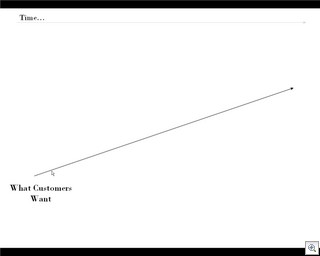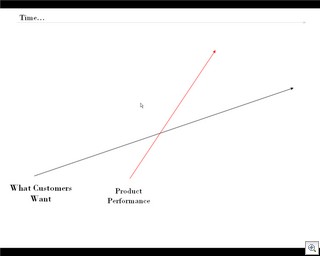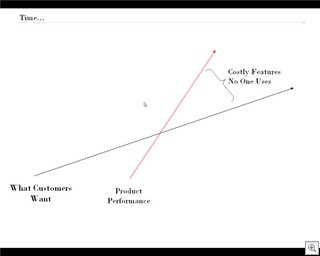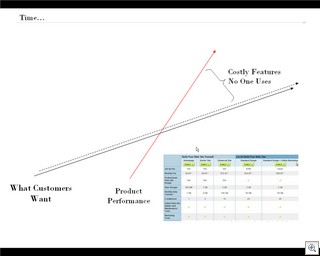 I’m knee deep in competitive analysis, market segmentation, brand differentiation and long-term visioning Tucows various retail web properties. There’s something like 11 in all that I’m now responsible for – Domain Direct, NetIdentity/NamePlanet, NewsHub, Blogrolling – the list feels endless.
I’m knee deep in competitive analysis, market segmentation, brand differentiation and long-term visioning Tucows various retail web properties. There’s something like 11 in all that I’m now responsible for – Domain Direct, NetIdentity/NamePlanet, NewsHub, Blogrolling – the list feels endless.
Something I read on TechCrunch this morning struck a particularly dissonant chord with me.
Marshall Kirkpatrick writes;
The Zoho team told me that if Basecamp targets “the less is more crowd,” ZohoProjects will be feature rich. It’s not there yet, but it sounds like a good strategy.
Techcrunch – “ZohoProjects challenges Basecamp on project management”.
I’m a long-time devotee of Clayton Christensen, so I couldn’t help but think “Wow – that is so *not* a good strategy…”
Let me explain…(using my own versions of CC’s famous slides as illustration…)
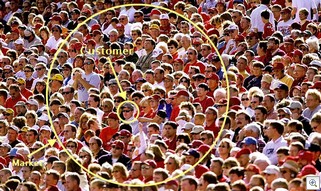 From a marketing perspective, there is no such thing as the “less is more crowd”. It simply does not exist as a market segment, a market or anything remotely resembling what could even be loosely defined as being a clustering of potential customers. Zoho is completely missing the boat if they think that 37Signals is targetting “the less is more crowd”.
From a marketing perspective, there is no such thing as the “less is more crowd”. It simply does not exist as a market segment, a market or anything remotely resembling what could even be loosely defined as being a clustering of potential customers. Zoho is completely missing the boat if they think that 37Signals is targetting “the less is more crowd”.
37Signals appears to understand that if they want to sell Basecamp to a particular market segment with a particular set of needs that all they need to do is figure out exactly what those needs are and then build functions that deal exactly with those needs into their service.
And that’s it.
They don’t waste any time trying to understand what features those customers might need, what features their competitors think those customers need, what features they think those customers might find cool.
No, they do eactly one thing – attempt to understand, at a very deep level, exactly which features and functions the desirable users need from a project management service and then build those features into their service.
 What I find remarkable though, is the attitude that this is some special brand of “Web 2.0 Voodo”. That “less-is-more” is something new. Less-is-more is simply a restatement of the old maxim, “Do one thing and do it well”. What is new is that increasingly, people are realizing that this is a smart (and profitable) approach to building compelling web services.
What I find remarkable though, is the attitude that this is some special brand of “Web 2.0 Voodo”. That “less-is-more” is something new. Less-is-more is simply a restatement of the old maxim, “Do one thing and do it well”. What is new is that increasingly, people are realizing that this is a smart (and profitable) approach to building compelling web services.
Here’s my take on Christensen’s spin on why “Less-is-more” is smart (and profitable).
Over time, customers needs will change. On the whole, these needs will grow greater as people become more familiar with the product you sell, and therefore demand more from it. What people are doing with computers today is drastically more sophisticated than what they were doing 5, 10 and 15 years ago.
In response to this, producers will generally enhance their products to meet these requirements.
The problem is, due to a variety of competitive factors, the rate at which producers enhance the capability of their products exceeds the rate at which customers needs increase. The reason that this is a problem is that this leads to excess performance capabilities – i.e. features that customers do want and aren’t using.
Every additional product enhancement has a measurable cost for producers. Typically, a producer expects to recoup these costs by appealing to more paying customers, which has the net effect of generating more revenue for the producer. But, if new features that don’t appeal to enough users to pay for themselves have a negative effect on the profitability of the producer. The feature has ended up costing more to implement than it will generate in revenue.
The only way to avoid this costly mistake is to figure out what problems the desirable customers are having and to solve the gnarliest of those problems with as little effort as possible. In the diagram below, this means figuring out how to plot the dotted line – how to stay just one step (not less, not more) ahead of where your customers need you to be.
 This requires developing a deep understanding the nature of the problem that these customers are running up against – which requires talking to customers, which implies an understanding of the market dynamics, etc., etc. None of this is quick or easy. If it were, all products would be perfect and all customers would be completely happy with everything they bought. This is the hard stuff – not only because it requires real heads-down “I’m-talking-to-customers-instead-of-going-to-the-TechCrunch-party-to-generate-buzz” work, but also because it requires a high level of discipline. The discipline to ignore the press releases that say that you are falling behind your competitors, the discipline to resist implementing some really cool new emerging standard that everyone swears will be the next big thing and most importantly, the discipline to listen to what customers are saying and understanding what they really mean (and to sort out the desirable customers from the undesirable ones who tend to do all the talking).
This requires developing a deep understanding the nature of the problem that these customers are running up against – which requires talking to customers, which implies an understanding of the market dynamics, etc., etc. None of this is quick or easy. If it were, all products would be perfect and all customers would be completely happy with everything they bought. This is the hard stuff – not only because it requires real heads-down “I’m-talking-to-customers-instead-of-going-to-the-TechCrunch-party-to-generate-buzz” work, but also because it requires a high level of discipline. The discipline to ignore the press releases that say that you are falling behind your competitors, the discipline to resist implementing some really cool new emerging standard that everyone swears will be the next big thing and most importantly, the discipline to listen to what customers are saying and understanding what they really mean (and to sort out the desirable customers from the undesirable ones who tend to do all the talking).
So back to Zoho. I think these folks have a serious product strategy problem. They have defined their product in terms of what one of their competitors is doing (“We will have more features than Basecamp”) rather than in terms of what their customers can demonstrably digest. Worse. they’ve also defined their marketing message in terms of their product type (“Manage projects online”) instead of defining it in terms of what their customers are trying to achieve (“Collaborate more effectively”)
 As Rex Hammock points out, this effectively means that Zoho is competing with Microsoft, not 37Signals. Not exactly what a startup needs to be doing. Exactly what I hope to avoid with Domain Direct and the rest of the services that I’m responsible for. With each, we’re closely looking at what problems we’re solving and which customers have those problems. With each, we’re looking to solve the toughest problems for the most desirable customers. And if we can’t, I’m going to recommend that we get out of the business.
As Rex Hammock points out, this effectively means that Zoho is competing with Microsoft, not 37Signals. Not exactly what a startup needs to be doing. Exactly what I hope to avoid with Domain Direct and the rest of the services that I’m responsible for. With each, we’re closely looking at what problems we’re solving and which customers have those problems. With each, we’re looking to solve the toughest problems for the most desirable customers. And if we can’t, I’m going to recommend that we get out of the business.
I have a lot of sympathy for software companies like Zoho and 37Signals. What they do is not easy. They have to be excellent at understanding their customers, excellent at designing software, and excellent at selling it. Complete focus is one of the most critical elements of achieving success. Which is where Marshall’s analysis of Zoho’s strategy falls apart. Zoho may have absolute focus on what’s important to them, but I’m not sure that they realize what’s really important. What 37Signals does, what Microsoft does, is one of the least important variables in their business. They can’t let 37Signals set the pace for them. Zoho needs to let their own customers set the pace.
If they don’t, they are quite likely going to invest a lot of money building a lot of features that the majority of their customers will ever use. At the same time, 37Signals is pretty likely going to invest a lot of money in building high quality features that their customers will use. In the end, 37Signals will end up with a lot more customers than Zoho at a much lower overall cost, and Zoho customers are going to continually be tempted by Microsoft’s marketing onslaught.
And that, in a very large nutshell is why more is actually less. Building more features than more of your competitors in an attempt to appeal to more customers requirements more money and more time, resulting in less profit. I really believe that less time spent building less features means less waste which means more customers, more happy customers and more profitable customers.
Hopefully this makes more sense than less 

